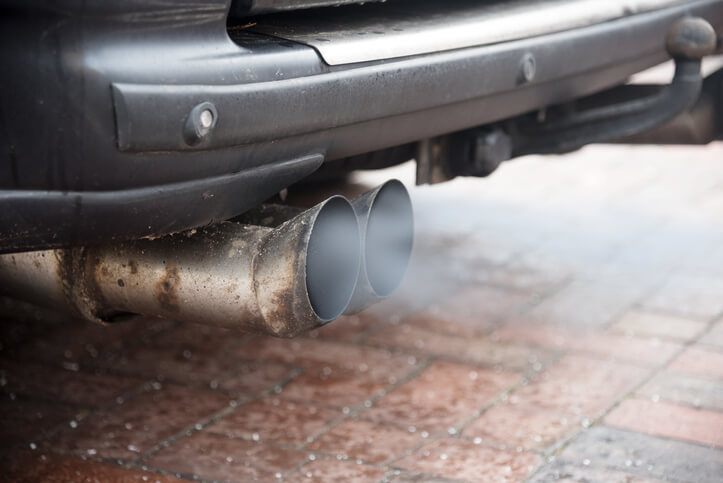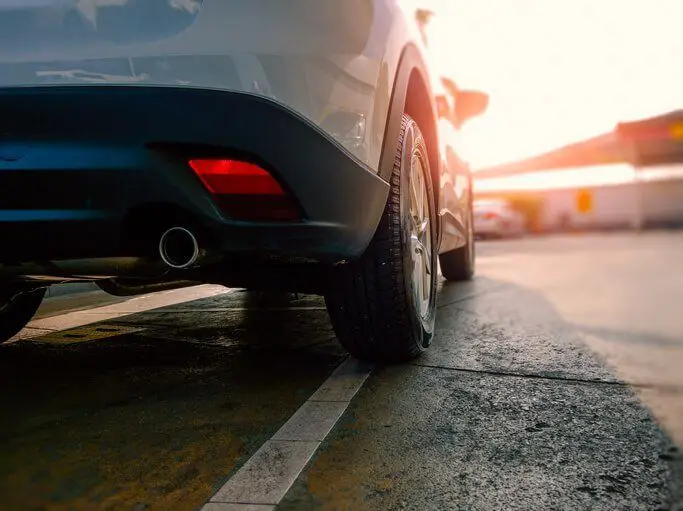A noisy exhaust can take all the fun out of driving unless of course you’re driving a sports car and the ear-splitting roar of the exhaust is a visceral part of it all!
If you’re reading this article chances are you don’t own a Lamborghini Gallardo, instead you probably own something a bit tamer and are having some problems with an excessively noisy exhaust.
Most cars now use exhaust mufflers which significantly reduces the sound coming from your exhaust, however if you own a relatively old car (15 years+) you may not have one.
This means that sound coming from your exhaust will be much louder and it will also mean that your exhaust may be more susceptible to getting damaged by road wear (stones flying up and hitting it) or rust, both of these can cause sound issues if they cause sufficient damage to create a hole in your exhaust pipe.
Looking for more ways to make your car quieter? Read our guide on soundproofing your car.
Issues That Will Cause Your Exhaust To Be Excessively Noisy
It may be that your vehicle just has a loud exhaust by default. If this is the case don’t worry there are plenty of things you can do (further down this page) to make it quieter.

Excessive exhaust noise is often caused by a fault with your exhaust. These can be identified by the sound your car makes so long as you know what sounds to listen out for.
Exhaust Noise Changes And What They Mean
In order to work out what exactly needs to be done to fix your exhaust you first need to identify where the problem stems from and to do that we need to understand what the sounds your exhaust makes mean.
If your exhaust starts making a very loud roaring sound then this indicates that your silencer is damaged.
If you hear a hissing noise then this indicates that gas is escaping from a part of your exhaust that it shouldn’t be escaping from, it is likely that you have developed a hole or a crack somewhere in your exhaust pipe.
If your exhaust sounds like it is struggling to get the gas out it may produce a chugging sound which would indicate that there may be something inside your exhaust which is blocking the gas from escaping.
Loud metallic rattling noises indicate that either your fittings have come loose and your exhaust is bouncing around a bit, or that your pipe may have become misaligned.
Visual Exhaust Checks
It is also worth having a look underneath your vehicle while the engine is running to see if you can visually identify the source of the noise.

To do this turn the engine on (taking care to leave the handbrake on and your vehicle in neutral), then lie down beside your car and watch for any holes, cracks and any signs of gas escaping.
Make sure you wear a face mask to prevent inhalation of dangerous unfiltered exhaust fumes.
You should also check for signs of rust, particularly on your cars silencer as this area is most susceptible to rusting due to how exposed it is and the chemical processes which occur within it causing build ups of acidic moisture.
If you notice any rust give it a poke with a screwdriver to see if it has rusted all the way through if it is just surface rust it isn’t too much of a problem however if it has rusted all the way through then your silencer will need replacing.
Other Ways To Make Your Car Quieter:
If you’re looking for other ways to reduce the amount of sound your car makes check out our article on quiet tires.
How To Fix & Soundproof Any Exhaust
There are a number of reasons why your exhaust may be making excessive noise. Some of these are relatively simple to fix, whereas others are likely to require assistance from a mechanic.
Below we are some of the most common exhaust issue and how to fix them:
A Small Hole Or Crack In The Exhaust Pipe
To fix a small hole in your exhaust (5cm or less) you will need; a steel brush, sandpaper, a small bit of chalk, acetone and exhaust tape or repair epoxy.
- 50g / 1.7 ounce Evo-Stik Hard & Fast Metal Epoxy Putty
- A strong waterproof fast setting epoxy putty that is designed for long lasting repairs
- Bonds to copper, brass, steel, aluminium, fibre glass, glass, hard plastics, wood and much more
To repair your hole follow the following steps:
- Jack up your vehicle.
- Support your vehicle with jack stands.
- Identify exactly where the holes are and mark them with chalk so that you can easily find them.
- Scrub around the hole using the steel brush to remove all dirt and allow for a tight seal.
- Rough up the pipe with sandpaper to allow your tape or epoxy to grip it better.
- Wipe around the hole with acetone to clean it.
- Wrap the exhaust tape around the hole. Be aware that different tape has different methods of sealing. Some require the pipes to be hot, other require the tape to be wet for it to seal.
A Big Hole Or Crack In The Exhaust Pipe
If you have a large hole or crack on your exhaust then the method to fix it varies slightly. A large exhaust hole would be anything which is more than 5 cm across.
You will need all the same materials as for a small hole; a steel brush, sandpaper, a small bit of chalk, acetone and exhaust tape or repair epoxy.
Also Read: 14 Of The Best Car Sound Deadening Materials
In addition to this for a large hole you will also need either an exhaust repair kit or a small bit of tin which can be cut from a soft drinks can, a strong pair of scissors and hose (or pipe) clamps.
Follow the previous steps 1-6 to get your exhaust ready. Then:
- Take your exhaust repair kit or soft drinks can and cut a large patch which will more than cover the hole, leaving plenty of room spare, (a patch which is big enough to wrap around the exhaust will be the most secure) this can be done using scissors.
- Cover the area around your exhaust pipe hole with epoxy, making sure that enough surface area is covered for all of your patch to be sealed.
- Place your patch into place and hold it there for a minute to allow the epoxy time to grip to it.
- Cover the patch in another layer of epoxy, taking care to ensure that you add epoxy all around the perimeter of the patch as this is where leaks are most likely to occur.
- Take a couple of hose clamps and clamp the patch tightly to the pipe with the clamps sitting either side of where the hole is. Tighten them up as much as you can. These hose clamps should remain in place permanently to secure the patch in place.
Rusted Exhaust
Most cars will rust sooner or later. Your exhaust is often the first thing to rust because of how exposed it is.
Rust may create the appearance of your exhaust being on its last legs but a lot of rust is only surface damage and serious work (like replacing your entire exhaust) may not be necessary.
Rust on it’s own won’t cause your exhaust to be excessively noisy unless it creates a hole in the piping.
To find out what the extent of the rust damage is, take a screwdriver and poke at the rust to find out if the exhaust has rusted all the way through or not.

If not you can treat rust by first sanding it all off and buffing it out, then using metal paint with high temperature resistance to paint your exhaust and seal it from the elements.
If it has rusted all the way through then complete steps 1-11 above, making sure that you take time ensuring that all rust is sanded off the exhaust and buffed out before sealing the hole.
Loose or Misaligned Exhaust Pipes
Over time bolts and fittings on your exhaust can come loose, if they do your exhaust will start to bounce around when you are travelling over rough or bumpy terrain, this can make a lot of loud metallic clanking noises which can vary in how loud they are depending on how loose your exhaust is!
Some of the most common issues which could cause a metallic clanging sound are:
- Loose or damaged exhaust pipe hanger hangers.
- Loose or damaged heat shield.
- A misaligned joint in the exhaust pipe.
- A loose baffle inside your muffler.
It is possible to diagnose exactly what the issue is by paying close attention to the type of rattle your exhaust is making.
High pitched ‘tin can like’ rattles indicate that a heat shield on the underside of your car has come loose.
Lower pitch bumping sounds indicate that a hangar may have come loose or broken or that your exhaust may have become misaligned.
If your heat shield has come loose then you will either need to reclip the shield to the body of your car or you will need to weld it back onto your exhaust pipe depending on how it was originally mounted.
If your exhaust pipe hangers have come loose. To do this simply wiggle the exhaust pipe around to try and replicate the clanking sound, this should quickly reveal where the pipe has become loose or misaligned. Once you have found out where the issue is then simply secure it correctly using a new hangar.
Once you’ve done this your noisy bumpy drives should become a thing of the past and you can once again enjoy driving in relative silence!
Excessive Engine Noise From Tailpipe
Excessive noise from your engine tailpipe means that your exhaust is probably fully functional, instead it is likely that the problems stems from your engine.

It may be that your engine is simply built to be loud or there could be an issue with it that requires further investigation. If you are concerned about the amount of engine noise that is coming from your tailpipe then you should get a diagnostics check done at a garage to confirm that there are no serious issues.
If your car simply has a noisy engine there are a few things you can do to help make your exhaust quieter:
Get A Better Muffler
A muffler exists to muffle the sound of your exhaust. If you are having problems with excessive exhaust sound and you have sealed up any gaps and secured your exhaust but still are not happy with the results then investing in a high-quality performance muffler is likely to make a significant difference.
When choosing a muffler make sure that you are careful to buy one which is designed specifically for your make, model and year of car.
Also Read: How to quieten a generator for related tips on dealing with noisy exhausts.
When you have found one that fits you will then need to remove your old muffler. These will often be rusted on due to years of water exposure so apply lubricant liberally to get the clamps and bolts off.
You may also need to use some penetrant spray to help break up the rust and allow you to slide the muffler off completely.
The method for attaching your new muffler will vary slightly depending on the product you buy, just make sure to check your manufacturer’s instructions to get it right. When securing your muffler be sure to use plenty of epoxy to seal the muffler which will help further quieten your vehicle’s exhaust.
Use An Exhaust Wrap
Exhaust wraps are designed to stop heat escaping from your exhaust pipe, they are more commonly used on motorbike exhausts where there is a danger that your leg my inadvertently come into contact with a scalding hot exhaust.
- Universal application. Withstands 1800F direct/2500F intermittent heat
- Promotes increased flow for improved performance. Reduces temperature & vibration breakdown
- Outperforms cheap aftermarket colored fiberglass tape insulation wraps
Exhaust wraps can help quieten an exhaust to a certain degree, the thicker a wrap you use the more impact it is likely to have, however adding an exhaust wrap will have less impact than fixing holes in your exhaust and getting a better muffler so you exhaust wraps as a finishing touch rather than your entire exhaust soundproofing strategy.
First make sure that you get a good quality wrap, otherwise it’s simply not worth investing your time in.
A good wrap to use would be something similar to the titanium heat wrap below which has a very high temperature threshold of 1400°C, these are better than most at soundproofing due to their dense titanium fibres.
- Universal application. Withstands 1800F direct/2500F intermittent heat
- Promotes increased flow for improved performance. Reduces temperature & vibration breakdown
- Outperforms cheap aftermarket colored fiberglass tape insulation wraps
To secure an exhaust wrap first you need to soak the wrap in water, then pull it tight, wrapping it slowly around and around your pipe, ensuring that you keep it tight as you go.
Every 10 cm secure it in place with a hose clamp. Keep going until the entire exhaust is covered and you’re done!
Also Read: Engine Lifter Tick Noise: Causes & How To Stop It
As an Amazon Associate I may earn a small fee from qualifying purchases at no extra cost to you. This helps us run the site, so thanks for your support!


I like that you mention how mufflers are meant to make your exhaust quieter, I installed one on my car recently and it made a HUGE difference!
Hi Tiffany, thanks for reading, yes mufflers are often all you need to sound deaden your exhaust effectively.